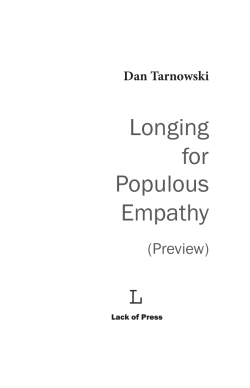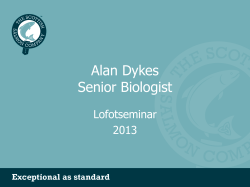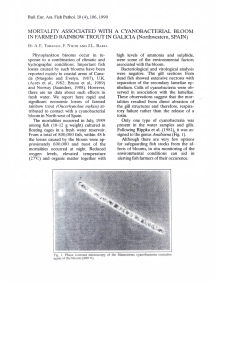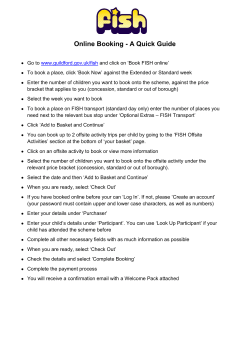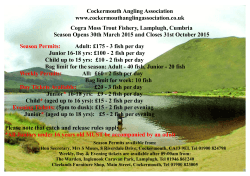
International Institute of Molecular and Cell Biology in
Anna Bartosik Ewelina Szymańska International Institute of Molecular and Cell Biology in Warsaw CU ND CELL A L IN S TI F MOLE BI OL AT N ION EO RA LA T TU Y • I NT E OG R Text by: Anna Bartosik, Ewelina Szymańska Illustrations: Łukasz Szozda Educational programme of the International Institute of Molecular and Cell Biology in Warsaw A L IN S ION TI U OL AT N OF MOLE C ND CELL RA BI LA TE TU INTERNATIONAL INSTITUTE OF MOLECULAR AND CELL BIOLOGY IN WARSAW Ks. Trojdena 4 Street 02-109 Warsaw, Poland Tel.: (+48 22) 597 07 00 Fax: (+48 22) 597 07 15 e-mail: secretariat@iimcb.gov.pl Y • I NT E OG R http://www.iimcb.gov.pl/ "Be Healthy as a Fish" ISBN : 978-83-917905-7-1 c International Institute of Molecular and Cell Biology in Warsaw. Text by: Anna Bartosik, Ph.D., Ewelina Szymańska, Ph.D. Illustrations/graphic design by: Łukasz Szozda, Ph.D. Translation and proofreading: Tirgum.pl Anna Zielińska Educational consultation: Dominik Marszał Project coordination: Joanna Korzeniewska First edition 2014 The book was released in an edition of 300 copies. Dear Reader, We’re very pleased that you’re holding this book in your hands. Before you read it, we would like to explain the origin of its title. You have probably heard the expression “healthy as a horse” many times before. Its Polish equivalent, which has inspired our title, is “healthy as a fish”. Have you ever wondered what this could mean? Do fish really never get sick? Unfortunately, they do. This popular and erroneous belief stems from the fact that people hardly have the occasion to observe unhealthy fish. In reality, however, like any other animals, including humans, fish also get sick. Why then was the book given a title that any careful observer will find untrue? We have decided to use this tricky idiom because it contains two words that are very important to us, namely ‘fish’ and ‘health’. The main character of the story that we’re going to tell you is a small fish, called zebrafish, which helps scientists find the cause of certain human diseases and discover medicines with which they can be treated. How? Let’s start from the beginning... Enjoy your read! Ania and Ewelina Be Healthy as a Fish Do you know this feeling when your favourite equipment breaks down? For example, when your PlayStation freezes or a wheel falls off your bike? You’ve probably noticed that even one broken element can stop the entire mechanism and make an object useless. This is because in every device even the smallest piece doesn’t work independently, but together with other parts. And only when all elements function properly the device will work flawlessly. Do you know how to fix a broken machine? Of course, there are many solutions, however not all of them will lead to success. You can try to repair a failure yourself or with some help from a friend, but you’ll probably be able to fix only a small failure in an uncomplicated device. 5 Be Healthy as a Fish In most cases you’ll have to seek the help of a specialist. It’s a person who knows the construction of a given device and its functioning perfectly well, and who is able to replace the broken part or repair the failure. You probably know that the basis of success is the knowledge of the construction and functioning of a device. Specialists have this sort of knowledge, whereas us, regular users of those devices, we often lack it. Try to think of the most complicated machine you know. What is it? A computer? A plane? A space rocket?! Whatever answer you’ve given, you’re wrong! Have you ever thought that the most complicated machine you know is your body?! It consists of very small basic elements, which are invisible to the naked eye, called cells. They are a little bit similar to soap bubbles that are stuck tightly to one another in foam. In reality, each cell is a microorganism – it breathes, feeds and is able to move. The inside of the cell is filled with a great many particles, which are in constant motion, continuously merge and split. Scientists call this phenomenon metabolism and for us it simply means ‘life’. These changes only seem chaotic on the surface, in reality they happen according to a plan. 6 Be Healthy as a Fish The execution of this plan is possible thanks to the presence of extremely hard-working particles called enzymes. It is thanks to them that changes of other particles in the cell can take place. Enzymes belong to a large group of compounds generally called proteins. Proteins have many other functions in the cell and so they are among its most important components. How do proteins get to the cell? Inside the cell there is a small ball that contains a long thread. The ball is the cell nucleus and the thread is acid which we call DNA - it’s the acronym, the full name is quite difficult to pronounce but you can give it a go, it’s: DNA is the most incredible particle on Earth because it contains coded information concerning the structure of proteins (including hard-working enzymes!). As you remember, proteins have many important functions in the cell and this is why we say that DNA contains information on the structure and functioning of cells (metabolism), and therefore of your entire body. Less than 2 metres (only slightly more than your height) of the DNA thread are enough to code this information. Please note that this long thread has to fit inside the cell! And to build your body, as many as 100,000,000,000,000 (one hundred million million, which is one hundred trillion) cells are needed. A DNA molecule looks like a twisted ladder. For discovering the structure of the ‘molecule of life’ James Watson and Francis Crick received the most important award in the world of scientists – the Nobel Prize. 7 Be Healthy as a Fish The human body is a great unknown. Various processes constantly take place inside it – in the lungs oxygen is absorbed from the air, and in the stomach and intestines food is digested. Blood transports oxygen and nutrients to cells, e.g. to muscle cells, which use them (with the help of enzymes) to produce energy, which we need to be able to move. Although we know the course of many processes happening in our body, there isn’t one single person on Earth who knows exactly how his or her body works. Of course, there are people who know more than others – these are scientists and doctors. However, even though they gather new information on the functioning of the body every day, they are still at the beginning of the path leading to the understanding of the secret of the human organism. But why do we actually need this knowledge? Let’s go back to the complicated machines that sometimes break down. If a single cell in the human body is much more complicated than all machines, even the most modern ones, then you have probably guessed that in the entire human body failures also happen. Such a failure causes an illness, which means that the organism isn’t functioning properly and we don’t feel well. Sometimes an illness can be caused by viruses or bacteria, which attack the human body (cells) and stop it from functioning properly. 8 Be Healthy as a Fish Much more often an illness is caused by errors that occur within us, e.g. damage to DNA. This causes an incorrect functioning of proteins in cells. These failures are frequently related to the ageing of the organism, which is when its effectiveness in detecting and fixing problems diminishes (fixing a failure is the process of healing). It explains why older people get sick more often than younger ones. Obviously, no one wants to be ill. To help our system combat an illness we need to: Know exactly what caused it Know where in the human body it occurred Find a substance that will make the organism function properly again You have to admit that it’s not an easy task. For hundreds of years scientists have been working on writing an ‘operation manual’ for this machine that the human body is. Can you believe that to learn more about the human organism scientists carefully observe the nature around us? Do you know why? 9 Be Healthy as a Fish Because by learning about the structure and functioning of other organisms we acquire greater knowledge about ourselves!!! How is it possible? It’s simple. People and animals have many similarities. It is related to the common history of all living organisms on our planet. You probably know very well that life on Earth didn’t always look like it does now. Over four billion years ago the first cell came into being (scientists still argue over how it happened). Later, the number of cells grew, the first organisms built of many cells were created (fungi, plants and animals), and subsequent generations of organisms changed their structure and became more and more complex. The whole process is called evolution. Play a detective and solve the evolution puzzle! Colour the correct arrows to draw a line from the first cell to man! 10 Be Healthy as a Fish Scientists, like detectives, want to recreate the course of the process of evolution. To do this, they compare the structure of various organisms that live on Earth. It’s a difficult task, because our planet is currently inhabited by as many as 9,000,000 different species, many species became extinct millions of years ago (I’m sure you’ve heard about dinosaurs), and there are still some species that remain unknown! Scientists carefully examine even those species that no longer exist, analysing fossilised skeletons and rock imprints extracted from the ground by palaeontologists (who examine extinct organisms). On the basis of many years of research, scientists prepared an evolutionary tree of organisms. It looks like a family tree of a very big family. The roots are the period of time when the common ancestor of all organisms (the first cell) existed and the thick branches denote the main lines of development of organisms, the kingdoms of fungi, plants and animals. The smaller branches are smaller families, which we call classes. In the animal kingdom, there are the classes of fish, amphibians, reptiles, birds and mammals. Life first began in the water and so fish were first (this is why they are on the lower branches of the tree), and only then did they develop into land animals, such as amphibians and reptiles. Reptiles gave rise to birds and mammals. No other classes originated from these two and so they’re on top of the branches of the evolutionary tree. 11 Be Healthy as a Fish Please note that the animal kingdom resembles a typical large family. The closer its members are related the more features they share (in the same way that you resemble your siblings more than your distant cousins). This fact is used by scientists who study the secrets of the human body. In what way? Let’s play science detectives. Our deduction (our way of drawing conclusions) is like this: if we’re related to animals then the processes that occur in their bodies must also occur in the human body. Let’s follow this track: also illnesses from which animals suffer will have a similar course in humans. And finally, like you’ve probably guessed: drugs that help animals will probably be effective also for us. It’s simple, isn’t it? 12 Be Healthy as a Fish Brain Spine Heart Limbs At first, it can seem that we don’t have much in common with fish, for example, but when we look more closely at the body of a fish and a human being, it turns out that there are a lot of similarities. For instance, to some extent, paired fins in fish and human limbs are constructed in a similar way and have a similar function (they facilitate movement). Even more similarities can be found inside the body of a fish and a human being. First of all, humans and fish have a spine (this is why they belong to a group of animals called vertebrates), a brain, muscles, a heart and blood vessels, which carry blood. If we look more closely at the cells of a fish and a human being, we’ll notice that there are many more similarities. Or that there are less and less differences. We could struggle to recognise which cell belongs to a fish and which one to a human being. This is because as much as 80% of information contained in the DNA thread is the same in humans and fish. These cells are almost identical. Can you find 5 differences? 13 Be Healthy as a Fish Let’s get back to our complex machines. To build a computer, an airplane or a space rocket, it is crucial to have the necessary materials and instructions on how to do it. Very often, when building complex structures, engineers start by building small versions of the machines, which they call models. It is on them that they check whether all designed elements will be compatible and work in harmony in the final version. This is what it looks like: Plan for the construction of a machine Model of a machine Machine As I’m sure you remember very well, the human organism resembles a complex machine, for which we don’t have a ready manual. And we need this manual to be able to fix our organism when it starts failing, when it’s ill. You can say that scientists work in reverse order to constructors of great machines. What does this mean? First, they analyse the structure and functioning of chosen organisms, usually of animals, and on the basis of this, they deduce what processes take place in the human body. We call them model organisms, because due to their structure (or anatomy) or processes that take place within them (or physiology) they constitute an imitation of the human organism. In a moment, you’ll learn about some of them! 14 Be Healthy as a Fish The word has many meanings. What do you think, which one best works in our case? Try to connect drawings with correct definitions. Try to use each path only once! a person employed to present fashionable clothes a smaller copy of a larger object, e.g. an airplane or a building an object similar to the original, the studying of which brings information regarding reality a type, a make of a specific brand, e.g. of a car an artistic project (in sculpture) or a person (a man or a woman) posing for a photographer, painter or sculptor 15 Be Healthy as a Fish So the work of a scientist looks like this: OF TE MO LE C L AT IONAL IN RN S U IT AR AN D CE UL L T To really know a model organism it’s not enough to perform simple observations in its natural habitat. Many types of examination have to take place in special laboratories of research institutes. They are equipped with necessary tools that enable a thorough observation of such an organism, especially its small cells. B IO G LO Y • I NTE One of such institutes is the International Institute of Molecular and Cell Biology in Warsaw. Do you think it’s an extremely complicated name that you won’t be able to remember? Don’t worry, we’ll explain it to you! 16 Be Healthy as a Fish nternational – Because scientists that work in it come from various countries, and not just from Poland. When people with various experience and knowledge meet in one place, together they can achieve more! nstitute – It’s the official name of a place in which scientists work. of olecular – It’s a difficult word deriving from the word ‘molecule’. Molecules are small particles that can be compared to the smallest cogs in a machine. Do you remember our comparison of cells to soap bubbles? We said that cell particles are in constant motion… Molecular biology studies the work of these particles, or molecules. As you’ve probably guessed, they’re so small that molecular biologists study things they can’t see! But they’re well aware of the fact that the work of these molecules is involved in the process called life. and ell – Well, life can be studied on many levels, not only molecules but also entire cells. Cell biologists use a microscope to study the functioning of cells in an organism. iology – The study of life. Maybe you can guess what acronym scientists use referring to the institute? It’s IIMCB. We’re also going to use it. Biologists from the IIMCB study various model organisms. Why? Because there isn’t one ideal model organism. Model organisms differ in terms of their size, structure and affinity to humans. And these differences help scientists a lot. You’re probably wondering why. Let’s try to explain it using an example. Yeast (yes, I mean the atypical fungi that cause a cake to rise when we bake it) are very simple organisms. They’re built of only one cell, which constitutes the entire organism. For this reason, they’re a good model in studies aiming to explain the functioning 17 Be Healthy as a Fish and structure of cells. Mice, on the other hand, are model organisms that in the great family of animals are closely related to humans. But the favourite model organism of researchers from the IIMCB is a small fish with a really nice name, namely the zebrafish. The zebrafish is native to the streams of the largest mountains in the world, the Himalayas. Its name was given to it because it has stripes, like those of zebras that live in Africa or those you can find on a pedestrian crossing. The zebrafish is a very vigorous fish who loves swimming. It’s sociable and interacts well with other fish, which is why it is often kept in fish tanks at home. It belongs to the carp family, which also includes its slightly bigger cousins, the carp and the goldfish. 18 Be Healthy as a Fish Scientists from the IIMCB have become so fond of zebrafish that they gave a part of their institute to them. In its basement you’ll find many rows of shelves. On the shelves, however, you won’t find jars, like at your grandma’s, but fish tanks with zebrafish. There are not one or two hundred, not even a thousand but over six thousand zebrafish there! It’s like a small fish town. It’s constituted by many fish families, each of them in a separate aquarium. There are a lot of pipes and cables everywhere, and in the background you can hear the hum of the fish town, as each little house has a light and a constant supply of fresh water with oxygen. 19 Be Healthy as a Fish On each aquarium there’s a plate with the name of the fish family that lives in it. The names are very peculiar. You won’t find any plates with such names as Smith or Jones, but you can find Casper (in honour of the friendly ghost), Dackel (which is the German name for the dachshund) or Pinscher. There are also more familiar names like Knypek (joystick) or Oko Meduzy (Medusa’s eye). Some names, such as Tg(Xla.Eef1a1:mlsEGFP) look like a real code. We owe these funny names to the imagination of scientists who bred those fish families (What would you call your zebrafish family?). Have you got any ideas for names for these three zebrafish? Write them on the signs they’re holding! Fish families differ in terms of the colour of their stripes, the length of their fins and other features which are known only to scientists. Can you find similarities in each vertical, horizontal and diagonal row? Three zebrafish in each of them have only one thing in common! 20 Be Healthy as a Fish Every day the fish town uses 250 litres of water (this much could fill up two bathtubs). The diet of zebrafish consists of fish food pellets of various sizes, suitable for the mouths of fish of different age. Twice a day the boring pellets are replaced with a real hunt, when the hunter’s instinct of a shark awakes in little zebrafish; in the end, it’s their distant cousin! Twelve thousand little fish eyes watch as the lids of their fish tanks are lifted and as they’re being filled with a rain of small crustaceans. These are larvae of Artemia salina, the favourite snack of zebrafish, which disappear in their tummies within a few seconds. There are also special safety rules in the town. When a new fish family comes to the institute, first it has to live in a separate place, because a veterinarian needs to make sure that its members do not carry any diseases that could be dangerous to other fish. We call this period quarantine. Are you wondering why scientists from the IIMCB are so fond of zebrafish? Because they are unique model organisms! They help scientists from the first hours of their lives! In the case of people, a new organism develops inside the body of its mum. It makes it really difficult to watch its development. It’s similar with other mammals (animals that after being born drink the milk of their mothers), like dogs, cats or mice. It’s different with fish. In their case, the joining of a cell from the mum with a cell from the dad takes place outside of the mother’s body – in the water. As a result of this joining, a new cell is created, which will grow and divide into daughter cells. They will gradually form a small fish, its tail, fins, head and internal organs. The entire process takes place in the water and so scientists can easily monitor it using a magnifying glass (or a microscope). The fact that during the whole process the fish is transparent is very important, because it makes it easier for scientists to observe how its heart, brain and other internal organs are formed. As a result of this, we know what happens in each hour of its development. 21 Be Healthy as a Fish Have a look at the timeline with the stages of development of zebrafish. 1 cell adult fish 4 cells 0 the fish is growing intensively, the fins and stripes appear 1 90 64 cells 2 the fish starts moving 2 days the heart starts beating 3 hours 1 1000 cells 6 12 8 the beginning of the tail the eyes start shaping Let’s summarise the most important advantages of zebrafish as model organisms: the females lay hundreds of eggs so they can have numerous offspring; small fish develop outside of the organism of their mother, so subsequent stages of their development are not a secret to us; fish are transparent, as stripes on their scales don’t appear until after a month (so until then we can easily watch how various organs work); fish grow very fast and can become parents as early as after three months (what do you think, how many consecutive generations of fish can scientists watch within one year?); 5 breeding them doesn’t require a lot of space and is cheap, so scientists from the IIMCB can breed as many as 6,000 fish at the same time! 22 Be Healthy as a Fish What can we learn about the human organism by observing zebrafish? You probably remember that the life of organisms begins with a single cell, which divides to create a complex multicellular organism. The entire animal family descend from one common ancestor and so the beginning stages of their development are always very similar, whether it’s about a fish or human embryo. Scientists carefully observe processes that take place in the development of the zebrafish. They study how cells divide and how they know that some of them are supposed to form the tail and others the heart. Thanks to this, we can imagine the development of a child in the mother’s stomach. Adult fish are also a mine of information for scientists. Similarly to humans, fish can get ill. Observing such fish is a valuable experience, because by analysing the course of their diseases we can understand what happens in the body of a person who’s ill. This knowledge will bring researchers closer to the most important goal, namely discovering medicines for illnesses that plague us. Do you know what a medicine is? A medicine a is substance obtained from other organisms or artificially produced. Administered to a person who’s ill, most frequently it fights the causes of the disease and helps the organism recover. In the case of exceptionally tricky diseases medicines can be less effective, but they still relieve unpleasant symptoms and stop the disease from spreading. Medicines can have various forms, such as tablets, pills, syrups, ointments, creams, powders, suppositories and drops. Taken in a wrong way medicines can become a poison. This is why they can only be bought in a pharmacy and usually only when it has been decided so by a doctor, who writes a prescription with the name of a medicine. From the moment when it’s been discovered in a laboratory to the moment when it becomes available in a pharmacy, a medicine has to go through a lot of tests and checks, which sometimes take many years. It is because the safety of future patients is crucial. Only those medicines can reach pharmacies that are effective and which don’t cause any other harmful effects in the body of a patient. 23 Be Healthy as a Fish How to discover a cure for a disease? Looking for a cure for a disease can be compared to a journey to the unknown. During this journey, the knowledge of the structure and functioning of the organism is our map. In order to understand how important knowledge about the human body is whilst working on the discovery of a new cure, first let’s try to experience this adventure completely unprepared. Imagine that you’re looking for a cure for a toothache. You try everything – you eat ice-cream, you rinse the aching tooth with cold water, you chew a mint gum, but none of these methods works. Although you spend a whole day searching, you’re not even one step closer to an important discovery. And your tooth still hurts… 24 Be Healthy as a Fish Looking for a cure without a plan of action is like moving around a labyrinth blindfolded! Find a way to the cure - but remember to avoid the viruses! We have to admit, however, that there have been some cases when a cure was discovered by accident. They’re all very interesting and the circumstances in which they happened memorable. For scientists they’re a wise lesson on the importance of perceptiveness and the ability to draw conclusions. 25 Be Healthy as a Fish The history of penicillin – long live coincidences! (And fungi too!) Professor Alexander Fleming was a microbiologist, which means that he studied bacteria. Absorbed in his work, he didn’t pay much attention to the cleanliness of his laboratory. Piling on tables and shelves were special containers, called Petri dishes, in which he bred bacteria. You can imagine his surprise when one day on one of the Petri dishes with growing bacteria, he noticed an additional guest, a colony of a fungus called Penicillium. Its spores must have been brought to the laboratory by wind through the open windows. Professor Fleming was an extremely attentive scientist, and so he noticed straightaway that the new inhabitant of his laboratory was unusual. Breaking all rules of hospitality, it made all bacteria with which it shared the Petri dish DISAPPEAR! How was it possible? How did it happen? Maybe the fungus produced a substance that was lethal for bacteria? Fleming’s hypothesis was correct and made him famous, because he discovered a new medicine – penicillin. His discovery saved the lives of millions of people, protecting them from diseases caused by bacteria. This amazing story took place not long ago, at the beginning of the 20th century. 26 Be Healthy as a Fish For his perceptiveness, professor Fleming was awarded the Nobel Prize. And penicillin and similar substances called antibiotics are medicines that have been used until present day. Chance discoveries happen extremely rarely, which is why to develop new medicines scientists usually use the following plan: It’s not an easy task. This is why scientists work in groups, which we call research teams. A group of people with various knowledge and experience can do more research than a single scientist, and group meetings and discussions make finding answers to biological riddles easier. In order to solve particularly difficult puzzles, scientists from various countries join their efforts. This is how international research projects are created, such as the FishMed, which is an abbreviation for Fishing for medicines. Do you know which model organism will be used in this project? Of course, the zebrafish! This is why a fish town has been created in the IIMCB, in which scientists observe the development and structure of healthy and sick zebrafish. They pay particular attention to the functioning of their cells. By comparing healthy and sick cells, they can discover causes of diseases. Scientists know many complicated ways in which they try to treat sick fish. 27 Be Healthy as a Fish They write about their observations and conclusions and share them with other researchers in the form of scientific articles. In 2013 almost 2,400 scientific papers about the zebrafish were written around the world! Most probably, this number will be bigger with each ear! What diseases are scientists interested in? Of course, all of them! But particularly those with a severe course, which make the life of people who suffer from them very difficult. For many of them no medicines have been developed or only such that aren’t very effective. Because people live longer and longer, it is more frequent that they suffer from diseases that only occur when they are old. Scientists from the IIMCB search for causes of such serious diseases as cancer, Parkinson’s disease and Alzheimer’s disease. Maybe you’ve heard about them; maybe you know or heard about someone who suffers from one of them. Finding an effective cure for these diseases is a difficult task. Although people live longer and longer, being able to celebrate one’s hundredth birthday is still quite a challenge. A person who reaches the age of 100 years old must have a unique organism. Scientists from the IIMCB have been interested in the life of Polish centenarians for many years. They asked them what diseases they went through and what their lifestyle was. They also drew samples of their blood for analysis. Blood contains cells, which – as you already know – contain DNA, information about the structure of the human organism. On the basis of information contained in the DNA of centenarians, scientists want to solve the secret of longevity. The research projects in the IIMCB on the health of Polish centenarians are called the PolStu and PolSenior. 28 Be Healthy as a Fish What is Alzheimer’s disease? It happens to all of us that we forget to do something, for example return a book to the library on time or bring sports shoes to a PE lesson. Forgetting is part of our everyday life and the older we are the more often we forget. But Alzheimer’s disease is more than just simple forgetting that happens to kids and adults. It’s a disease that causes irreversible changes to the brain of the person who suffers from it and sometimes even remembering simple tasks becomes impossible. An old person suffering from Alzheimer’s can have problems even with remembering the names and faces of members of his or her family. Scientists have managed to develop medicines that relieve symptoms of this disease but they still haven’t found a substance that could cure it. Test your memory! Look at this picture and memorise as many details as you can. On the next page you will find three questions about the picture. Answer them and find out how good your memory is! 29 Be Healthy as a Fish Let’s go! Answer the questions and see how good your memory is! What colours were the fish in the framed picture on the wall? How many crayons were there on the desk? How many teeth did the cogs that the fish was thinking about have? blue and green pink and green pink and blue two three four six seven eight What about Parkinson’s disease? Parkinson’s disease also attacks old people. To understand its symptoms let’s try to think of an example from our own life. Do you sometimes get nervous before a maths test or when you’ve forgotten to do your homework and your hands are shaking? This can happen to anyone but imagine that this condition never goes away. This is exactly what happens when someone suffers from Parkinson’s disease. It’s a disease that attacks the nervous system, which is the centre commanding all our movements. A person who suffers from it gradually loses control over his or her movements, e.g. his or her hands keep shaking. Such people have difficulties moving, talking and performing simple activities. Sometimes they can be very sad because they’re not as agile as they used to be and they can no longer organise bicycle expeditions with their grandchildren. 30 Be Healthy as a Fish Did you know… Alzheimer’s disease and Parkinson’s disease owe their names to the two doctors who first described their symptoms in patients. How observing fish can help us find medicines for Alzheimer’s disease or Parkinson’s disease? The symptoms of these diseases in people are forgetting and incoordination. They’re caused by incorrect functioning of cells in the nervous system (it consists of the brain and nerves coordinating muscles). It is on this cell level that the diseases have a similar course in zebrafish and people. Fish can have completely different symptoms, but the causes are the same. Zebrafish live shorter than people, so in the FishMed project scientists can observe many generations of fish with the symptoms of Parkinson’s disease or Alzheimer’s disease. Finding out about the causes helps in the search for effective medicines. With each year, Alzheimer’s disease and Parkinson’s disease affect more and more people. Frequently, entire families have to face their consequences. Grandmas and grandpas, who looked after their grandchildren when they were small, now often suffer from illnesses and require care and assistance themselves. 31 Be Healthy as a Fish How can YOU help? There are many ways, but sometimes a walk and a nice conversation is enough; you can visit sick people in hospital and read them from their favourite book or listen to music with them. You can tell them about your experiences during your visit to the IIMCB and about scientists who work there to learn about the course of the disease and develop an effective cure. You can tell them about the fish town, what it looks like and how many residents it has, and about many other interesting things that you learnt from this book. Did you enjoy this journey through secrets of biology? Maybe one day you’ll decide to join scientists in the IIMCB? Our door is always open to young heads full of questions and ideas! Before we say goodbye, here’s a question for the most persistent and careful readers: Do you remember the full name for DNA? 32 Be Healthy as a Fish Glossary – The study of life. – A disease caused by an uncontrolled division of abnormal cells. They replace healthy cells and can spread to the entire human body causing a dangerous disease. – The smallest structural and functional part of living organisms. Sometimes, an entire organism can consist of one cell, e.g. bacteria. Animals and plants are built of many cells, which create large clusters called tissues. Cells can vary significantly in terms of their size and shape. (also: illness) – A state of an organism in which it’s not functioning properly. – Genetic material found in the cell. It’s the ‘operation manual’ of the cell and of the entire organism. Information contained in DNA is divided into fragments, which we call genes. Each gene has its function in the organism; e.g. there are genes responsible for the colour of your eyes or your blood type. These traits are inherited, we receive them in the form of genes from our parents, which is why we resemble them. – The process of changes in organisms over the course of many years. – A research project realised in the IIMCB, which through the observation of the zebrafish will provide us with new information needed to develop medicines for various diseases, including Alzheimer’s disease and Parkinson’s disease. 33 Be Healthy as a Fish (the International Institute of Molecular and Cell Biology) – A research institute in which scientists from many countries cooperate to learn about the mechanisms of the functioning of the human organism. – A room dedicated to conducting scientific research. – All chemical processes that take place in living cells. – An organism that has been thoroughly studied by scientists in laboratories. On its example scientists try to understand the structure of the cell and the entire organism. Model organisms can be simple yeast, consisting of just one cell, some bugs and insects (e.g. the fruit fly, which loves nibbling at fruit that we leave on the table during summer months), fish or mice. – A research project realised also in the IIMCB, which will provide us with new information about the health of elderly people. – A group of organisms that are very similar to one another. 34 F MOLE CU ND CELL BI AT N EO OL T TU RA LA A L IN S ION TI Educational programme “Be Healthy as a Fish” Y • I NT E OG R Dear Adults, We are giving your children, students and tutees the book “Be Healthy as a Fish”, which is part of a bigger educational programme under the same name that is being conducted by our Institute. Educating the youngest in the biology of fish and other issues related to scientific research is not an easy task. We have undertaken an attempt to arouse their interest in something that scientists in our Institute do every day. We encourage you to read the book with them and take part in our educational programme “Be Healthy as a Fish”. For more information, please visit the website www.iimcb.gov.pl. Prof. Jacek Kuźnicki Director of the International Institute of Molecular and Cell Biology in Warsaw The FishMed project supports an innovative research programme using the zebrafish. Partner of the educational programme
© Copyright 2025
